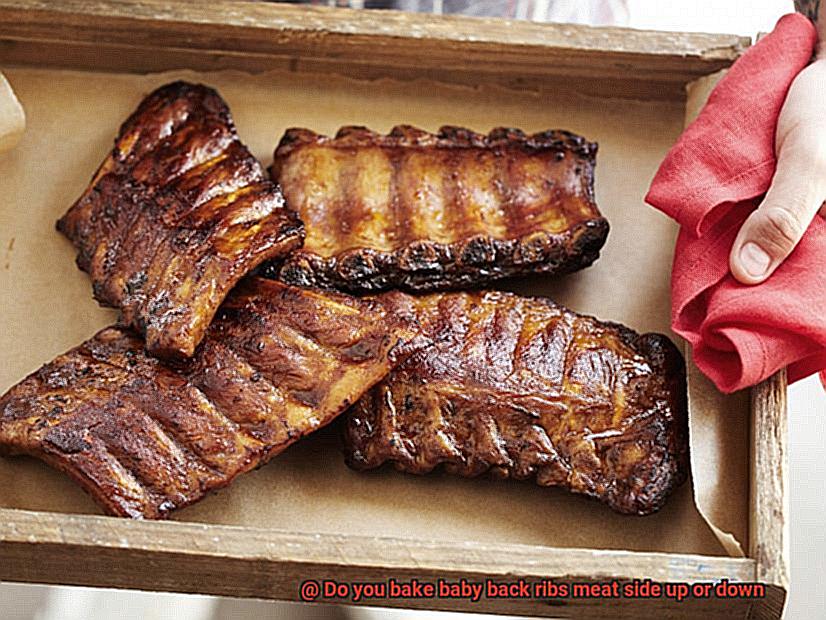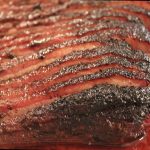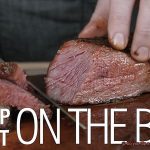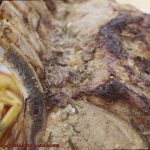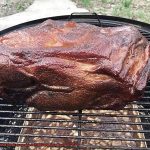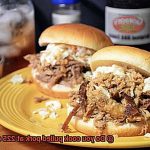Brace yourselves for a tantalizing journey into the realm of baby back ribs – those succulent, melt-in-your-mouth wonders that demand time, patience, and a whole lot of tender love and care. But amidst the smoky haze of grilling greatness, one question reigns supreme: Should you bake baby back ribs meat side up or down?
Prepare to witness the epic clash between grill masters and backyard enthusiasts as we embark on a quest to settle this sizzling debate once and for all. We’ll dive deep into the pros and cons of each method, empowering you to make an informed decision based on your unique taste preferences and desired outcome.
So, strap on your trusty apron and get ready to unlock the secrets of rib baking, as we unravel the mysteries that shroud this culinary conundrum. Whether you’re a seasoned pitmaster or a novice griller yearning for rib perfection, fear not – we’ve got you covered with all the juicy details necessary to elevate your rib game.
Contents
What Is the Best Way to Bake Baby Back Ribs?
When it comes to baking baby back ribs, there is no shortage of opinions on the best way to achieve tender, juicy, and flavorful results. In this article, we will explore the two most popular methods – baking the ribs meat side up or down – and offer tips for success along the way. So, grab your apron and let’s dive into the great debate of baking baby back ribs.
Method 1: Meat Side Up – The Juicy and Flavorful Approach
Baking baby back ribs meat side up is a tried and true method that promises a mouthwatering result. As the ribs cook, the fat from the meat renders down, basting the ribs in its flavorful goodness. This process not only keeps the meat tender and juicy but also allows the seasoning and rubs to penetrate deeply, creating a crust that bursts with flavor. With every bite, you’ll savor the succulent meat with its perfectly balanced blend of spices.
Method 2: Meat Side Down – The Leaner and Slightly Crispier Option
For those seeking a leaner alternative, baking baby back ribs meat side down is an excellent choice. By placing the ribs directly on the baking sheet or rack, any excess fat melts away, resulting in a final product that is less greasy.
This method also creates a slightly crispier texture on the surface of the meat, adding a delightful crunch to complement the tender interior. Each bite will provide a satisfying contrast between a savory exterior and a succulent center.
The Best of Both Worlds: A Combination Approach
If you find it challenging to choose between juicy tenderness and crispy texture, fear not. Some experts suggest a combination approach that offers the best of both worlds. Begin by baking the ribs meat side up for part of the cooking time. This allows for proper seasoning and rendering of fat, ensuring a flavorful and moist result. Then, flip the ribs over to finish cooking meat side down, allowing for a deliciously crispy exterior. This method guarantees a harmonious blend of flavors and textures that will leave you craving more.
Tips for Success:
- Properly season your ribs before baking by applying a dry rub or marinating them overnight. This step enhances the flavor profile and ensures that each bite is bursting with taste.
- Utilize low temperatures and slow cooking to achieve tender and flavorful results. Baking baby back ribs is a labor of love that demands patience but rewards you with exceptional taste.
- Consider using a basting sauce or marinade during the cooking process to add extra moisture and flavor to the ribs. A brush of tangy barbecue sauce or a glaze of honey-infused marinade can take your ribs to the next level.
- Always use a food thermometer to ensure that the internal temperature of the ribs reaches a safe level. This step guarantees that your ribs are not only delicious but also cooked to perfection.
Baking Baby Back Ribs Meat Side Up
Settle the age-old debate of baking baby back ribs meat side up or down with this guide. Discover the benefits of cooking them meat side up, including enhanced flavor, beautiful caramelization, and a moist and tender final product. Get ready to create mouthwatering ribs that will leave you craving more.
Preparing the Ribs:
To achieve optimal results, proper preparation is key. Begin by removing the membrane from the bone side of the ribs to enhance flavor absorption and tenderness. Season the ribs with a dry rub or marinade of your choice and allow them to marinate in the refrigerator for a few hours or overnight for maximum flavor infusion.
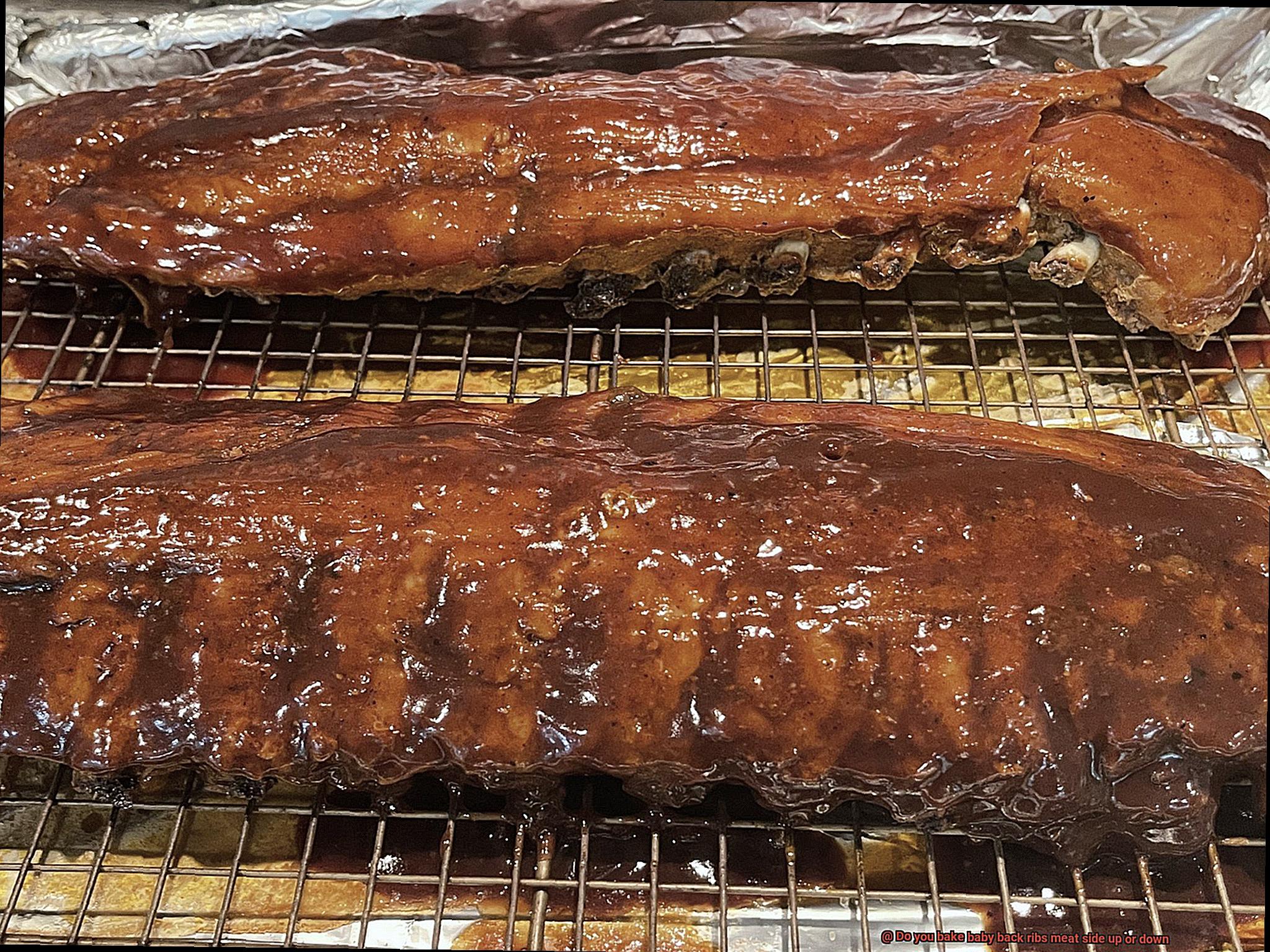
Positioning the Ribs:
When choosing to cook baby back ribs meat side up, position them on a baking sheet or in a roasting pan with the bone side facing down. This ensures even heat distribution and prevents sticking or burning. The heat will penetrate through the meat, creating a beautifully browned and caramelized exterior.
The Benefits of Meat Side Up Cooking:
Cooking baby back ribs meat side up offers several advantages. Firstly, it allows for better browning and caramelization, resulting in a visually appealing final product that will impress your guests. Secondly, as the fat renders down into the meat, it keeps it moist and tender throughout the cooking process. The flavors meld together perfectly, creating a succulent eating experience.
Cooking Time and Temperature:
Preheat your oven to around 300°F to 325°F before baking your baby back ribs. The cooking time will vary depending on the thickness of the meat and desired level of tenderness. Generally, it takes about 2 to 3 hours for baby back ribs to bake in the oven. Use a meat thermometer to check that the internal temperature reaches around 190°F to 205°F for doneness.
Resting and Serving:
Once cooked to perfection, remove the baby back ribs from the oven and allow them to rest for a few minutes. This resting period allows the juices to redistribute, resulting in tender and juicy ribs. After resting, slice the ribs between the bones and serve them with your favorite barbecue sauce or enjoy them as they are.
Advantages of Baking Baby Back Ribs Meat Side Up
One technique that can make all the difference is baking them meat side up. Trust me, once you try it, there’s no going back.
One of the first advantages of baking baby back ribs meat side up is the improved presentation. Picture this: a platter of perfectly cooked ribs with a caramelized glaze and beautiful grill marks, all showcased on the top side. It’s like a work of art that will have your guests drooling before they even take a bite. So if you’re hosting a barbecue or just want to impress your friends and family, this method is a game-changer.
But it’s not just about looks; baking baby back ribs meat side up also enhances the flavors in ways you can’t even imagine. When you place the ribs with the meat side up, all the juices and fats from the meat are retained on the surface. As they cook, these fats render down and baste the meat, creating a delicious crust and adding depth to the overall taste. The result? Ribs that are moist, succulent, and bursting with flavor.
And let’s not forget about tenderness. By baking baby back ribs meat side up, you achieve optimal tenderness. The fat from the top layer drips down onto the meat, creating a self-basting effect that keeps the ribs moist and tender throughout the cooking process. Plus, by keeping the meat side up, you ensure better heat circulation around the rack, resulting in more even cooking and tender ribs every time.
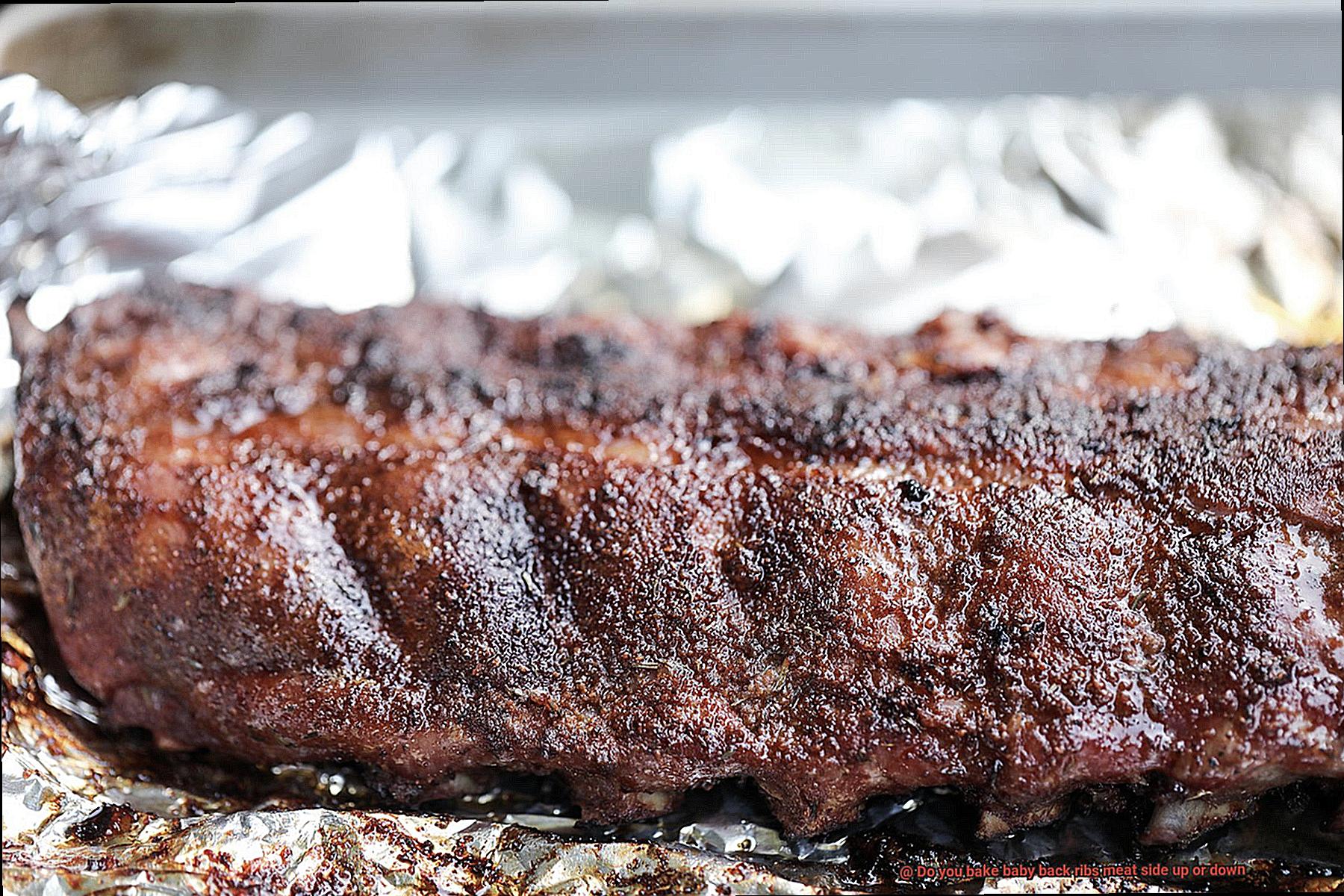
Now, here’s a bonus advantage: baking baby back ribs meat side up reduces the risk of overcooking or drying out the meat. The bones act as a protective barrier between the heat source and the meat, preventing direct heat from causing excessive charring or drying. This method allows for a slower and more controlled cooking process, ensuring that your ribs stay juicy and flavorful without becoming tough or dry.
Last but not least, baking baby back ribs meat side up makes sauce application a breeze. By starting with the meat side up, you can easily brush on your favorite sauce or glaze, allowing it to coat the ribs evenly. The flavors penetrate the meat and caramelize on the surface, creating a sticky and delicious coating that will have you reaching for seconds.
Disadvantages of Baking Baby Back Ribs Meat Side Up
While baking baby back ribs meat side up may seem like the obvious choice, there are some disadvantages that you should be aware of. So, put on your apron and let’s explore the risks and rewards of cooking these delectable ribs meat side up.
Disadvantage 1: Flavor Flair Fiasco
Baking baby back ribs meat side up can result in a lackluster flavor experience. When the meat side is exposed directly to heat, it tends to dry out faster, robbing your beautifully marinated ribs of the juiciness and flavor you crave. Additionally, the fat and juices struggle to penetrate into the meat when it’s facing upwards, resulting in less tender and less tasty ribs.
Disadvantage 2: The Uneven Cookout
Prepare yourself for an uneven cooking disaster. Cooking baby back ribs meat side up can lead to uneven heat distribution across the surface of the ribs. This means that while some areas may be overcooked, others remain undercooked. Say hello to tough and chewy bits mixed with tender and succulent sections – a far cry from the ideal eating experience.
Disadvantage 3: Missing that Crispy Crunch
Craving a crispy and caramelized exterior on your ribs? Well, if you’re baking baby back ribs meat side up, achieving that desired crust may prove more challenging. Without direct contact with the heat source, those sugars in your barbecue sauce or rub struggle to caramelize and create that delicious smoky and crispy texture we all yearn for.
Disadvantage 4: Flare-ups and Charred Chaos
Disadvantage 5: Basting Blues
Cooking baby back ribs meat side up can make basting or glazing your ribs during the cooking process trickier. With the meat side facing upwards, applying sauces or marinades evenly becomes a challenge. The result? Some parts of the ribs end up overly saucy while others lack that delicious flavor infusion.
Baking Baby Back Ribs Meat Side Down
Proper preparation is key. Start by removing the membrane from the back of the ribs, allowing flavors to penetrate the meat effectively. Season your ribs with a dry rub or marinade of your choice and let them marinate for a few hours or overnight.
Preheat the oven to a low temperature, around 275°F (135°C). Place your ribs on a baking sheet or in a roasting pan, meaty side down. This positioning allows the fat to render and baste the meat as it cooks, resulting in mouthwatering goodness.
Cover your ribs with aluminum foil to retain moisture during cooking, preventing them from drying out and ensuring they stay juicy. Bake for about 2 to 2 ½ hours until they reach an internal temperature of 165°F (74°C).
For the perfect finishing touch, consider giving your ribs a quick sear on the grill or under the broiler. This caramelizes and slightly chars the exterior, adding an extra layer of flavor and texture.
Allow your beautifully cooked ribs to rest for about 10 minutes before serving. This allows the juices to redistribute throughout the meat, resulting in a more flavorful eating experience.
Advantages of Baking Baby Back Ribs Meat Side Down
Well, get ready to tantalize your taste buds because today we’re diving into the advantages of baking baby back ribs meat side down. This cooking method is sure to take your grilling game to the next level, resulting in juicy, tender, and flavorful ribs that will have your friends and family begging for seconds.
First and foremost, baking baby back ribs meat side down helps in retaining moisture. As the ribs cook, the fat and juices from the meat drip down into the baking pan, creating a natural basting liquid. This keeps the meat moist and succulent throughout the cooking process. No one wants dry and flavorless ribs, right? So, let those juices work their magic by placing the meat side down.
Not only does baking baby back ribs meat side down help with moisture retention, but it also enhances the flavor. When you place the ribs meat side down, the seasoning and marinade can directly come into contact with the meat, resulting in a more intense and delicious flavor profile. Each bite will be bursting with savory goodness that will have your taste buds dancing with delight.
Another advantage of this cooking method is that it promotes even cooking. The heat from the oven circulates around the ribs, ensuring that they cook evenly on all sides. Say goodbye to undercooked or overcooked areas. With meat side down, you’ll achieve a consistent texture and taste throughout each and every rib.
Now let’s talk about that irresistible crispy bark. By baking baby back ribs meat side down, you allow the exposed bone side to develop a delicious caramelized crust known as the bark. This adds an extra layer of texture and flavor that will make your ribs truly unforgettable. Trust me, once you sink your teeth into that crispy bark, you’ll never go back.
But it’s not just about taste – convenience matters too. Placing baby back ribs meat side down makes them easier to handle during the cooking process. The bone side provides stability and acts as a natural handle for flipping or transferring the ribs without causing any damage or breakage. No more fumbling around with tongs or spatulas – this method keeps things simple and stress-free.
Last but not least, let’s talk presentation. When you serve your baked baby back ribs, the bone side can be placed facing up, showcasing that beautiful caramelized bark. It’s like a work of art on a plate – a feast for the eyes before it becomes a feast for the stomach. Your guests will be impressed by both the taste and the visual appeal of your perfectly cooked ribs.
Now, I must acknowledge that personal preference plays a significant role in cooking techniques, and some may argue for baking meat side up. And hey, there’s no harm in experimenting and finding what works best for you. But if you’re looking for moist, flavorful, and perfectly cooked baby back ribs, then give baking meat side down a try. Trust me, your taste buds will thank you.
Disadvantages of Baking Baby Back Ribs Meat Side Down
Attention, grill masters. If you’re a rib enthusiast like me, you know that achieving the perfect balance of tenderness, juiciness, and flavor is the holy grail of rib cooking. But did you know that baking baby back ribs meat side down can hinder your quest for rib perfection? Today, we’ll dive into the world of grilling and uncover the disadvantages of this method. So fire up those grills, grab your favorite sauce, and let’s get started.
Less Flavorful and Tender Meat:
Baking baby back ribs meat side down denies you the heavenly caramelized crust that adds depth of flavor and texture to your ribs. Grilling allows the meat to brown properly, enhancing the overall taste.
Greasier End Result:
Placing the ribs meat side down can lead to a greasy mess as melting fat pools around the meat. Grilling allows excess fat to drip away, resulting in leaner and more enjoyable ribs.
Dry and Tough Ribs:
Direct contact with the baking sheet causes moisture loss, resulting in dry and tough ribs. Grilling locks in moisture, producing succulent ribs every time.
Challenging Texture:
Uneven heat distribution when baking leads to unevenly cooked ribs – some parts may be overcooked while others remain undercooked. Grilling provides better heat control for a desirable texture throughout.
Lackluster Presentation:
Baking baby back ribs meat side down means missing out on that beautiful golden-brown color that grilling imparts, making your ribs visually appealing.
Other Considerations When Cooking Baby Back Ribs
When it comes to cooking baby back ribs, there are several other considerations to keep in mind that will take your rib game to the next level. Let’s dive into these expert tips and tricks:
Temperature control is key. Maintain a consistent temperature of 225-250°F (107-121°C) for slow and even cooking. Use a grill or smoker with a built-in thermometer or an external thermometer to monitor the temperature.
Don’t forget the seasoning. Apply a dry rub or marinade to the ribs before cooking. Let the ribs sit covered in the seasoning for a few hours or overnight in the refrigerator for maximum flavor penetration.
Prepare your grill properly. Ensure even distribution of coals for charcoal grills or preheat gas grills to the desired temperature. Soak wood chips in water for 30 minutes before adding them for that extra smoky flavor.
Slow and low cooking is the way to go. Baby back ribs need about 3-4 hours at 225-250°F (107-121°C) to cook to perfection. Use a meat thermometer to check for doneness, aiming for an internal temperature of 190-203°F (88-95°C).
Let them rest. After cooking, let the ribs rest loosely tented with foil for 10-15 minutes. This allows the juices to redistribute within the meat, resulting in a more flavorful and tender eating experience.
Sauce it up. Apply barbecue sauce during the last 30 minutes of cooking for a caramelized glaze. Brush on both sides, adding additional layers if desired.
Serve with a bang. Traditional barbecue sides like coleslaw, cornbread, baked beans, or potato salad are perfect accompaniments to baby back ribs. Offer a variety of barbecue sauces or rubs on the side for customization.
nxH4IjK7yAQ” >
Conclusion
When it comes to baking baby back ribs, the age-old debate of meat side up or down has divided grill masters and home cooks alike. But fear not, for I am here to shed some light on this culinary conundrum.
Traditionally, many people believe that cooking ribs with the meat side down allows for better basting and tenderizing. The theory is that as the fat renders and drips down onto the meat, it creates a self-basting effect, resulting in juicy and flavorful ribs.
On the other hand, there are those who argue that placing the meat side up allows for better caramelization and browning. By exposing the meat directly to the heat source, you can achieve a beautiful crust that adds a delightful texture and depth of flavor to your ribs.
Well, it ultimately comes down to personal preference. Both methods have their merits and can yield delicious results. Whether you choose to go meat side up or down, what truly matters is ensuring that your ribs are cooked to perfection – tender, moist, and packed with smoky goodness.
So, fire up your grill or preheat your oven, grab your favorite rubs and sauces, and get ready to embark on a mouthwatering rib adventure. Experiment with different techniques until you find the one that suits your taste buds best. After all, there’s no right or wrong way when it comes to enjoying these succulent baby back ribs.

